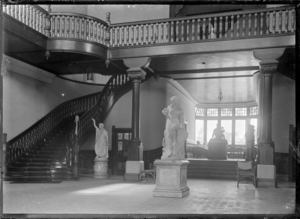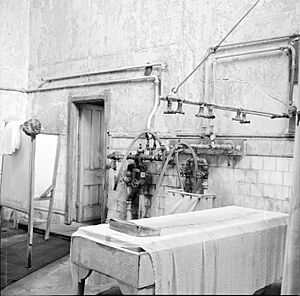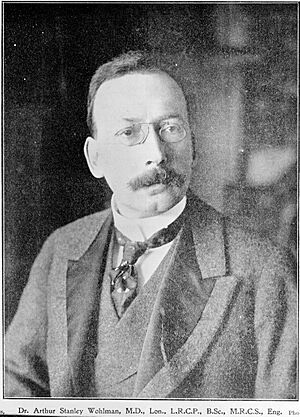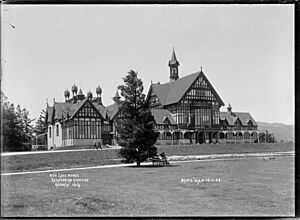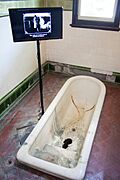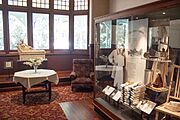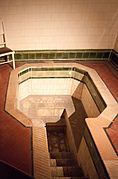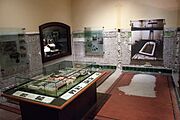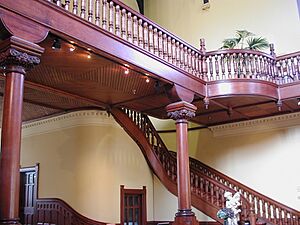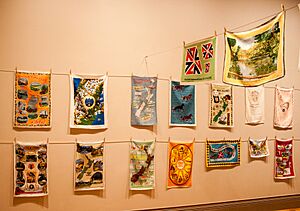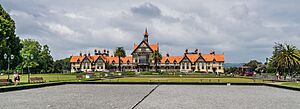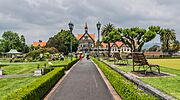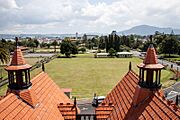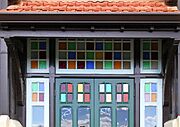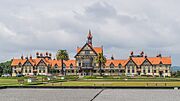Rotorua Museum facts for kids

Te Whare Taonga o Te Arawa
|
|
| Former name | Rotorua Museum of Art & History Te Whare Taonga o Te Arawa |
|---|---|
| Established | November 1979 |
| Location | Rotorua |
| Type | Art museum, Taonga, Social History |
| Designated: | 4 April 1985 |
| Reference #: | 141 |
The Rotorua Museum is a special place in Rotorua, New Zealand. Its Māori name is Te Whare Taonga o Te Arawa. It's a museum and art gallery found in the Government Gardens. The museum shares the amazing art, culture, and history of Rotorua and New Zealand. It has more than 2,000 precious Māori treasures called taonga.
The museum has been closed since 2016. This was because of damage from an earthquake. The building is a very important historic site. It is being made stronger and fixed up.
Contents
History of the Museum Building
Early Days of Rotorua Tourism
In the late 1800s, many tourists wanted to visit Rotorua. They came to bathe in the warm, natural pools. These pools were near the famous Pink and White Terraces. Because of this, the government decided to make Rotorua a tourist town in 1880.
On November 22, 1880, a judge met with 47 Māori leaders. They talked about creating a new town. The Ngāti Whakaue people generously gave 50 acres of land. This land was along the southern part of Lake Rotorua. This area is now called the Government Gardens. It is where the Rotorua Museum stands today. The land was given 'for the benefit of the people of the world.'
The Famous Bath House
In Europe, spas were popular places. People went there to treat illnesses or just to socialize. The New Zealand government hoped to attract rich tourists. They wanted them to visit Rotorua's new Bath House. These visitors could stay for weeks. They would use the baths to help with their health.
The Department of Tourist and Health Resorts was created in 1902. This department was in charge of building the Bath House. It took two years to build, from 1906 to 1908. It cost a lot of money back then, about £40,000. The Bath House opened in 1908. The Prime Minister, Joseph Ward, opened it. It was New Zealand's first big spa. It was also the government's first major investment in tourism.
The Bath House was known for its special water treatments. The water came from nearby hot springs. People believed these baths could help with many illnesses. These included Rheumatism, Indigestion, and nerve problems. Men were treated in the north wing. Women had their treatments in the south wing.
The Bath House tried to attract visitors from all over the world. A commander from the American Atlantic Fleet was invited to the opening. At its busiest, 60,000 to 80,000 people visited each year. This was a huge number. Rotorua's population was only 4,700 in 1926.
By the 1940s, spa treatments became less popular. Doctors started to say that spas were not a cure-all. They said spas should only help with hospital treatments. A new director, Dr. G.A.Q Lennane, said that promoting spas as a main treatment was wrong. He wanted science to be used instead.
In 1963, the Rotorua City Council took over the Bath House. By 1966, all treatments moved to a nearby hospital. Also, the building's metal pipes were rusting because of the sulfur in the water. It became too hard to keep up. So, the Bath House closed down in 1966.
The Museum's Beginning
The Rotorua Museum is now located in the old Bath House building. The Rotorua Museum first opened in the south wing of the Bath House in 1969. The Rotorua Art Gallery opened in the north wing in 1977. In 1988, the Museum and Gallery joined together. They became the Rotorua Museum of Art and History Te Whare Taonga o Te Arawa.
Until 1990, parts of the building were used for other things. There was a nightclub and two restaurants inside.
Rotorua Museum Bath House Exhibition
The Museum Today
The Rotorua District Council manages the Rotorua Museum. The building has a special look with its half-timbered style. Some people call it 'the most impressive Elizabethan Revival building in New Zealand.' It is also known as 'the most photographed building in New Zealand.'
The museum closed in 2016. This was because it did not meet New Zealand's earthquake safety rules. In 2023, the Rotorua Lakes Council decided to continue fixing the building. This will allow it to reopen. Construction started in June 2024. The repairs are expected to finish in 2027.
Collections and Exhibitions
The museum has many different types of collections:
- Māori treasures
- Fine Arts
- Photographs
- Social History
- Natural Environment
- Studies of cultures
As of 2021, the museum owned 2,490 artworks. About 55% were given as gifts. 45% were bought. Only 1% were specially ordered. The collection also has over 70,000 images of Rotorua. In total, there are about 55,000 items in the museum's collection.
Library and Archives
The museum's library has many books and documents. Most of these are about the history of the Te Arawa people. They also cover the Rotorua area. The collection includes rare books and old maps. There are also local publications and business records. Diaries and personal writings are also kept here. Information about the Bath House's history is available. The library also has files from past museum exhibitions.
Gallery
See also
 In Spanish: Museo de Rotorua para niños
In Spanish: Museo de Rotorua para niños



